MEMORIES
AND INFORMATION - STAFFORDSHIRE
PATTINGHAM
HOME GUARD
This
is a page within the www.staffshomeguard.co.uk website.
To
see full contents, go to SITE
MAP.
|
The Pattingham Home Guard was a unit
of the 24th (Tettenhall) Battalion, South Staffordshire
Home Guard. The following fascinating article which describes
the activities, organisation and personalities of the unit,
appeared in a newsletter of the Pattingham Local History
and Civic Society written by the Society's Secretary, Mr.
Peter Leigh. Staffshomeguard.co.uk is most grateful to the
Society and to Mr. Leigh for allowing us to reproduce it
in its entirety here.
THE
PATTINGHAM HOME GUARD
Immediately, the term "Home
Guard" conjures up images of that wonderful TV series
'Dad's Army', which hilariously poked fun at characters
and situations created whilst doing their bit for the war
effort.
Pattingham's Home Guard was called "D"
Company, and formed part of the 24th Staffs. (Tettenhall)
Battalion, and comprised four platoons :
17 Platoon, H.Q: the Reading
Room, Pattingham.
18 Platoon, H.Q: The Institute, Burnhill Green.
19 Platoon, H.Q: Kingswood Camp.
27 Platoon, H.Q: a Nissen Hut at Nurton.
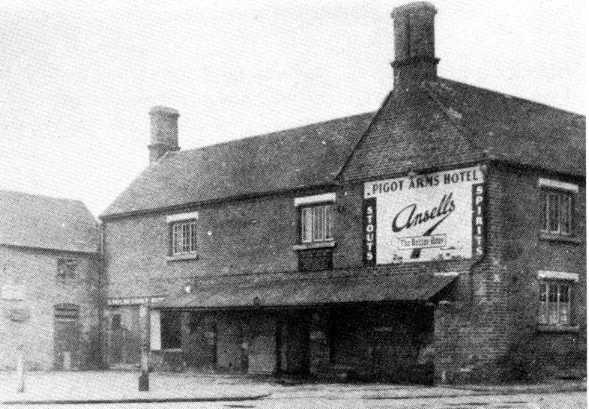 The
H.Q. of "D" Company was the Pigot Arms in Pattingham
(right). 17 Platoon had a member
of Signals (No.4) Platoon assigned to it, as the communication
specialist - and he was Corporal
W.T. Astley. (We know him in Civvy Street, as
Tom Astley, the Greengrocer
Man, who had lost an arm in an accident in his youth, and
about whom we have written in earlier newsletters.) The
H.Q. of "D" Company was the Pigot Arms in Pattingham
(right). 17 Platoon had a member
of Signals (No.4) Platoon assigned to it, as the communication
specialist - and he was Corporal
W.T. Astley. (We know him in Civvy Street, as
Tom Astley, the Greengrocer
Man, who had lost an arm in an accident in his youth, and
about whom we have written in earlier newsletters.)
It is Tom's daughter, Margaret
Powell, now living in Paignton, Devon, who has
generously presented our Society with a copy of a book called
"24 Home Guard, the record of 24th Staffs.(Tettenhall)
Battalion from 14th May 1940 to 3rd December 1944"
written by the Group Commander, A.J.
Parkes, and published in 1946; and with Tom
Astley's citation from
King George VI and his Certificate of Proficiency for his
signals studies.
The establishment of the Home Guard in 1940
had the very serious intent of providing a fifth column
of disruption and defence during the invasion of Britain
by Germany, whose occupation of Britain was a real and feared
prospect at that time. Whilst we may laugh and ridicule
over sixty years later, it was far from being a laughing
matter at that time.
The book is well written and provides us
with an excellent record of that time, and an invaluable
source for our local history. I have extracted references
to Pattingham "D" Company - in many cases quoting
directly from the book, in order to produce this article.
Persons wanting to make a more serious study should refer
to the original script by A.J.
Parkes.
There is no doubt, that many members of
the Home Guard, enjoyed their war, and Pattingham's "D"
Company had their fair share of Dad's Army experiences that
might have found their way into the TV script. Some are
referred to in this article, but I hope that by publishing
this, we shall spark off more tales and memories for us
to record in living memory interviews, from the few remaining
survivors of this era in our community, before they get
forgotten.
The organisation of the
24th Battalion was as follows:
24th STAFFS
(TETTENHALL) BATTALION
(H.Q: Nethy House, Wergs Road, Tettenhall)
Signals (No. 4) Platoon
H.Q., Company
"A" Company (Codsall)
"B" Company (Wombourne)
"C" Company (Tettenhall)
"D" Company (Pattingham)
"D"
Coy. was sub-divided as follows:
"D"
COMPANY (PATTINGHAM)
( H.Q: Pigot Arms)
H.Q. Company (Pigot Arms)
No. 17 Platoon (Reading Room)
No. 18 Platoon (The Institute, Burnhill Green)
No. 19 Platoon (Kingswood Camp)
No. 27 Platoon (Nissen Hut, Nurton)
Strength of "D"
Coy. at Stand Down (3rd December 1944):
"D" Company H.Q:
4 Officers; 10 WO's & NCOs; 2 Men = 16
No.17 Platoon: 1 Officer; 10
WO's & NCOs; 29 Men = 40
No.18 Platoon: 1 Officer;
7 WO's & NCOs; 15 Men = 23
No.19 Platoon: 2 Officers;
9 WO's & NCOs; 34 Men = 45
No.27 Platoon: 1 Officer; 10
WO's & NCOs; 16 Men = 27
Total = 151 men
Battalion Totals:
69 Officers; 300
WO's & NCOs; 793 Men = 1162 in total.
"D" H.Q. Company
Company Commander (until
February 1944): Major Harold
A. Page
Company Commander (after February 1944): Major
T.F. Hazell, DSO, MC, DFC.
Second in Command: Capt.
H.L. Warner
Quartermaster: Lt. G. Dyke
Intelligence Officer: Lt.
G.H. Hall-Jones
Company Sergeant Major: F.
Moseley
Company Quarter Master Sergeant: H.S.
Dyke
Medical L/Cpl: Albert W.H.
Jackson
Medical Cpl: W.H. Stokes
Chemical Warfare Sgt: Harold
Taylor
Intelligence Cpl: K.A. Lloyd
Intelligence L/Cpl: T.H.
Holdsworth
Cook Cpl: J.T. Bentley
Cook Cpl: W. Hutchings
Administration Sgt: W. Burdett
The main contact with the Civil Defence Services was with
the Police. They were the existing and original force concerned
with the protection of the area both from internal and external
trouble. Everyone had to be approved by the police before
he could be enrolled in the Home Guard or, (as it was known
until July 1940), the L.D.V. (Local Defence Volunteers).
Women helped from the beginning at Battalion H.Q. and several
of the Companies, but were not admitted to the Home Guard
until 1943, and even then they could not be enrolled or
wear uniform, but were given a plastic badge. They were
known as "nominated women", - though no-one seems
to know why! There were 25 registered.
"Our duty to the Police
would have been considerable in the event of an invasion,
and would have included the control of civilians, refugee
and otherwise, the protection of property, the cordoning
of roads and so on."
The national alarm signal was that church
bells had to be rung if paratroops landed in the immediate
vicinity.
Initially, as the name L.D.V. indicated,
it was a Volunteer Service, but conscription - or compulsory
enrolment as it was called - was introduced on 22nd January
1942. Up to that date, a volunteer could give 14 days notice
to resign. Men over 50 were outside the scope of conscription,
but no volunteers over 50 in the Battalion took advantage
of this concession, even though failure to do so meant that
they had to remain in the Home Guard until the end. A Subsistence
Allowance was instituted: 1/6d (7.5p)
for 5 hours; 3/- (15p) for
10 hours; and a maximum of 4/6d (22.5p)
for longer, and compensation for loss of earnings was paid
when attending courses and musters.
"The amount of private money spent
by all ranks without hope of repayment, and the private
labour of typists, experimental staffs and maintenance
people at the works of Home Guards were immense. The H.G.
was a hobby and as such many people were keener about
it than their paid work!
"During the first phase, from 14th
May to 26th June 1940, we were not trained nor had we
adequate arms for anything else but to observe and pass
on information. Although many patriotic sportsmen came
forward with their shot guns, sporting rifles, all sorts
of revolvers, we were very short of arms. We toured the
whole countryside on foot or bicycles at night looking
for paratroops.
"This operational duty provided many
incidents. It was on one of those rare wet evenings in
early June 1940, that six members walked the mile from
Pattingham to the Clive Observation Post. This was not
to be an ordinary picket; firstly, we were armed: between
the six of us we had an old Long Lee-Enfield, a real rifle
with a real bayonet on the end and one real round of ammunition
up the spout, (a round of Mark VI 1914 vintage, much burnished
with Shinio). In true tradition, a council of war was
held and a plan devised for the discomfort of the Hun
should he come that night. It was agreed that as Second-in-Command
Hall-Jones, the owner,
had fired this rifle some twenty years ago, it was to
be his privilege to mow down the oncoming Teuton horde
with one round, then a volunteer more fleet of foot was
to take over the weapon and finish off the survivors with
cold steel, ably assisted by the rest armed with divers
farm implements. A rota was drawn up, two stalwarts to
patrol the road, to be forewarned of enemy approach and
to discomfort those who return home with other's wives,
- the rest to sleep in the new Guard Room (two rooms above
the loose boxes in which Mr.
Williamson, the farmer, kept his pigs.)
"But this was a night
of great import for the Clivian sow - a time for the birth
of many pigs and so beneath the sleeping guard she pigged.
Never had a sow in labour grunted louder or had her new-born
young greeted the world with louder squeaks of joy, and
through the floor there rose a mighty smell of pig. How
sweet was the rain-washed road after the uneasy sleep
in that odoriferous guard room!"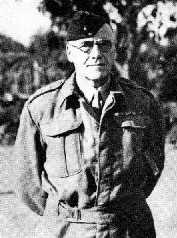
(right
Capt. H.C.Warner 2 i/c "D"
Company based at Pigot Arms H.Q.)
"A shipment of P17 (.300) rifles
arrived from USA in July 1940. They were US Army Rifles
of the Kaiser's War, and had been packed in grease for
21 years. The rease was more than thick - it was solid!
It took a great deal of sweat to make them fit for use.
"The first shots of "D"
Company were fired at the Clive, but not in anger. At
dawn one day a youthful Tommy
Ray was emptying the magazine when one refractory
bullet escaped up the spout, passing in its lethal flight
the ear of the reclining shepherd Volunteer
Pritchards. It takes something to surprise
a long-experienced shepherd, but to his feet he sprang
- or would have done had not his chair collapsed. With
the blast, out went the lamp, and in the ensuing darkness,
a scene of horror spread across those minds, and when
with a shaking hand a match was lit, there lay poor Pritchards's
corpse - unstruck - if shook!"
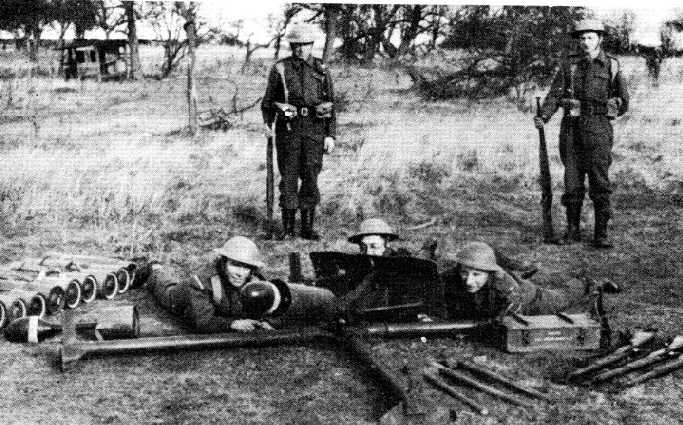
"D" Company Spigot Mortar Team
Pte. S. Weston;
Pte. J.R. Pinches; L/Cpl. G.A. Stokes; L/Cpl. A.J. Chamberlain;
Sgt. J.T. Ray
By 1944 "D" Company had the following
equipment:-
85 Rifles
2 Lewis guns
35 Sten Carbines
3 Browning Medium Machine Guns
2 Northover Projectors
2 Spigot Mortars
1 Boyes .55
"Arms, ammunition and
explosives had to be stored and accounted for with the most
meticulous care. The variety of ammunition was considerable
owing to the many kinds of weapons that were issued, and
was kept in 29 steel Ammunition Huts spread over the Battalion
area, and placed on requisitioned land."
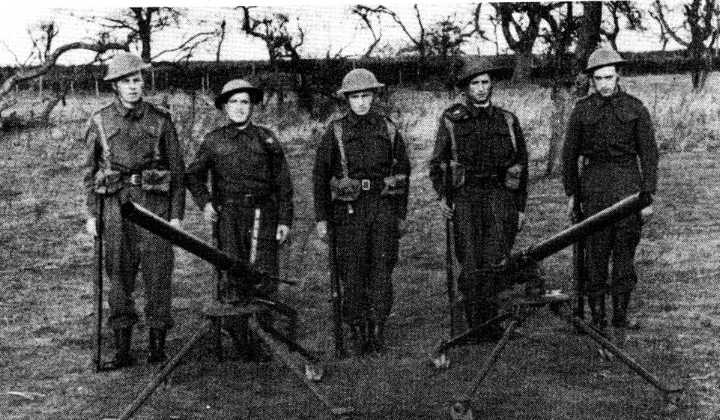
"D" Company Northover Projector Team c. 1943
Pte. K.R. Caseley;
Pte. T.A. Postance; Sgt.S.T. Ray; Pte.H.T. Downes; Pte.H.
Parkes
"Lord Dartmouth
had lent us his Rifle Range in Patshull Park. Ammunition
of any kind was almost negligible in quantity, but we
managed to scrounge a certain amount, enough for every
man to fire five rounds and a little left over for operations;
in fact it was not until the summer of 1944 that we were
able to build up to 140 operational rounds per rifle and
also have an adequate quantity for practice.
In addition to the Rifle Range, Lord
Dartmouth placed the whole of the Park at our
disposal and it immediately became the centre of our training
activities. He also lent the Golf Club House for use as
an Officers Mess and the tenant farmer allowed us to use
the outbuildings as we required. We constructed ranges
for live grenade practice, sten and miniature rifle shooting,
and in the low Park we could fire live Spigot Mortar,
Northover Projectors, and the 68 and 36 from the Emergency
Rifle. We had an assault course and a booby trap. Every
weekend throughout the summer of all the years about 100
men were trained in weapons and tactics".
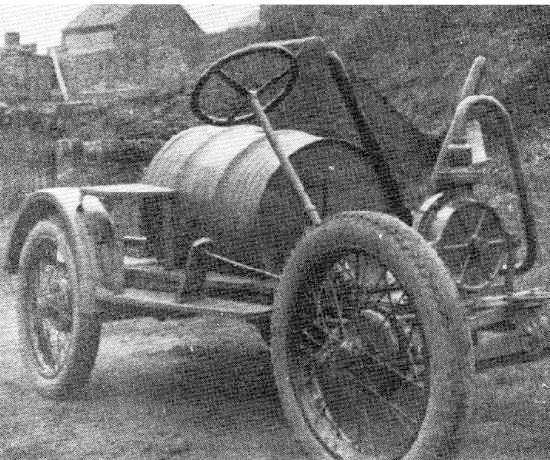
"There were many home
made improvised training expedients produced by all ranks.
The Area Commander came to see a demonstration of them on
a field at Wightwick in the early summer of 1941. The Nuttall
flamethrower (left) functioned
amazingly well. Its 75 foot flame was fearsome and lasted
for 3 minutes. The 50 gallon tank containing the mixture
was mounted on an Austin 7 chassis which was towed behind
a car. Its operational site was under the bridge at Dam
Mill and we felt sure that it would have dealt the enemy
a deadly blow."
"The Medical Officer's first large-scale
medical exercise was held at Pattingham in the early summer
of 1942. The Red Cross and St. John's Ambulance ladies
of the village co-operated and set up a Regimental Aid
Post at the Vicarage, which was in fact their own C.D.
First Aid Post. The exercise was attended by many spectator
officers and proved to be the prototype on which our future
training and our defended locality organisation could
be based".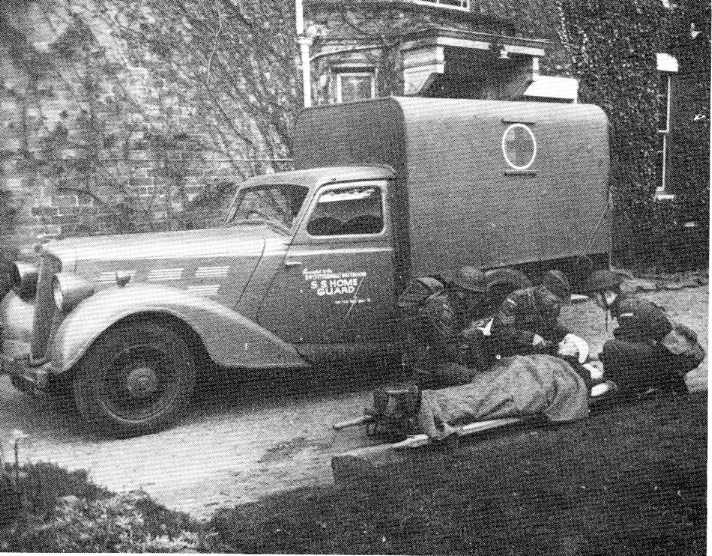
© Pattingham Local History and Civic Society
2006
FURTHER INFORMATION
Pattingham Local History
and Civic Society is anxious to seek out memories of Home
Guard life in and near the village from those who served
or have other memories of the organisation. To contact
the Secretary, please click
here. Alternatively if you prefer to make contact
via staffshomeguard.co.uk using FEEDBACK
we shall be happy to pass on your comments to the Society.
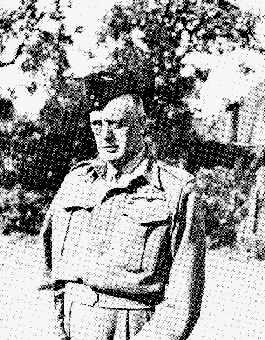 Major
Thomas Falcon Hazell (1892 -
1946) who commanded "D" Coy. from February 1944
had previously had a remarkable career in the Great War.
After volunteering in August 1914 and later being commissioned
into the Royal Inniskilling Fusilers, he transferred to
the Royal Flying Corps in the summer of 1916. He served
in Nos. 1, 24 and 123 Squadrons of the R.F.C. and R.A.F.
His total of 43 victories over enemy aircraft and observation
balloons was the sixth highest in the list of British
Great War "aces" and only one behind that of
the legendary Captain Albert Ball. It was achieved on
the Western Major
Thomas Falcon Hazell (1892 -
1946) who commanded "D" Coy. from February 1944
had previously had a remarkable career in the Great War.
After volunteering in August 1914 and later being commissioned
into the Royal Inniskilling Fusilers, he transferred to
the Royal Flying Corps in the summer of 1916. He served
in Nos. 1, 24 and 123 Squadrons of the R.F.C. and R.A.F.
His total of 43 victories over enemy aircraft and observation
balloons was the sixth highest in the list of British
Great War "aces" and only one behind that of
the legendary Captain Albert Ball. It was achieved on
the Western
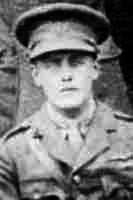 Front
between 4th March 1917 and 4th October 1918 flying Nieuport
17 and SE5a machines. In this period he was awarded the
Military Cross, the Distinguished Flying Cross, a bar
to the latter and finally the Distinguished Service Order.
The citations to these awards include such phrases as
"…On several occasions he displayed marked courage
and determination in attacking and destroying hostile
aircraft……This officer is conspicuous for his bravery
and skill……Relentless in attack, Capt. Hazell displays
disregard of personal danger in a marked degree…A brilliant
fighter, distinguished for his bold determination and
rare courage…" In the 1920s, having taken
a permanent commission in the RAF, Major Hazell commanded
squadrons in Iraq. He was born and eventually died in
Ireland. Front
between 4th March 1917 and 4th October 1918 flying Nieuport
17 and SE5a machines. In this period he was awarded the
Military Cross, the Distinguished Flying Cross, a bar
to the latter and finally the Distinguished Service Order.
The citations to these awards include such phrases as
"…On several occasions he displayed marked courage
and determination in attacking and destroying hostile
aircraft……This officer is conspicuous for his bravery
and skill……Relentless in attack, Capt. Hazell displays
disregard of personal danger in a marked degree…A brilliant
fighter, distinguished for his bold determination and
rare courage…" In the 1920s, having taken
a permanent commission in the RAF, Major Hazell commanded
squadrons in Iraq. He was born and eventually died in
Ireland.
Some time during the life of the Home
Guard, a dinner for members of the local
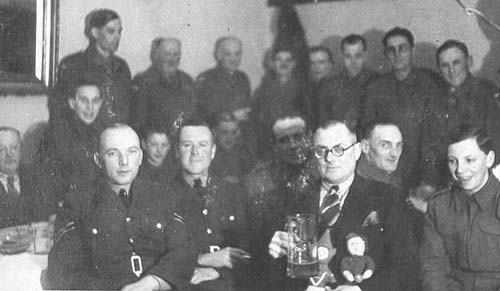 unit
took place in the Pigot Arms. Amongst those pictured are
Mr Hann, Fred Moseley,
Jack Moseley, 'Speedy'
Tom Ray, Eric Reynolds,
Mr Dignan (RAF Perton),
Ted Groves (RAF Perton),
Charlie Harley, Tom
Malpass and Jack
French. unit
took place in the Pigot Arms. Amongst those pictured are
Mr Hann, Fred Moseley,
Jack Moseley, 'Speedy'
Tom Ray, Eric Reynolds,
Mr Dignan (RAF Perton),
Ted Groves (RAF Perton),
Charlie Harley, Tom
Malpass and Jack
French.
(Photo by courtesy of Pattingham Local History Society)
|